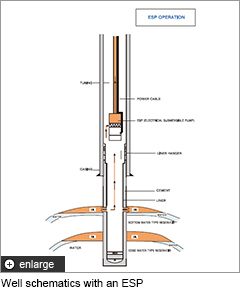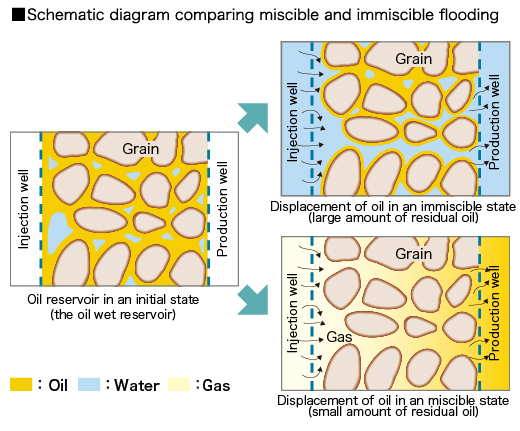Our Business

Our Business

Home > Our Business > Maximizing The Oil Recovery
The oil recovery is one of the most important concerns to the oil field operators. Since maximizing the oil recovery and minimizing the amount of un-recovered crude oil is the most essential assignment of the company, field operators from all over the world have devised many oil recovery techniques, such as water flooding , gas injections and steam injections to name but a few.
It is believed that one of the key issues regarding the recovery process is the adoption of the best applicable technique befitting each characteristics of the oil field. We have been challenged to maximize the oil recovery by applying the best possible production techniques and conforming to the individual characteristics of the Mubarraz, Umm Al-Anbar and Neewat Al-Ghalan Fields.
 The characteristics of the Mubarraz Field are that a large aquifer exists around the oil reservoir. An influx of a large amount of water into to reservoir results in an increase in oil recovery by displacing oil, but also results in an increase of water cut in the production and decline in the productivity of the wells, leading to the cessation of production by natural flow. Meanwhile, the fluid properties of crude oil in the Mubarraz Field show that the saturation pressure at which gas liberates from the crude oil is significantly lower than the initial reservoir pressure, and therefore, the decline in the reservoir pressure to a certain extent does not affect the oil recovery because no gas phase appears in the reservoir throughout the field life.
The characteristics of the Mubarraz Field are that a large aquifer exists around the oil reservoir. An influx of a large amount of water into to reservoir results in an increase in oil recovery by displacing oil, but also results in an increase of water cut in the production and decline in the productivity of the wells, leading to the cessation of production by natural flow. Meanwhile, the fluid properties of crude oil in the Mubarraz Field show that the saturation pressure at which gas liberates from the crude oil is significantly lower than the initial reservoir pressure, and therefore, the decline in the reservoir pressure to a certain extent does not affect the oil recovery because no gas phase appears in the reservoir throughout the field life.
In order to allow the oil wells to keep producing and to increase the oil recovery, an electric submersible pump (ESP) has been installed in the wells, taking advantage of the above mentioned characteristics of the field. As the reservoir pressure declines with the oil production by ESP, the water encroachment into the reservoir from surrounding aquifer is accelerated in all directions, thereby achieving a high oil recovery.
The characteristics of the Umm Al-Anbar and Neewat Al-Ghalan Fields are such that there is almost no aquifer around the oil reservoir, and therefore, a lesser amount of water is produced, however, crude oil is associated with a large amount of gas. The oil recovery is being maximized at these oil fields by injecting the associated gas into the oil reservoirs. Gas injection displacements can be generally classified into two processes, namely, immiscible and miscible displacements. An immiscible displacement is used in the usual gas injection method mainly designed to maintain the reservoir pressure. On the other hand, a miscible displacement is a technique which can significantly improve the oil recovery. We have encouraged and applied the so-called high pressurized natural gas miscible flooding in both Umm Al-Anbar and Neewat Al-Ghalan Fields, in order to maximize the oil recovery and production of the fields. We have also employed a gas cycling method for the near critical fluid reservoirs; which show gaseous fluid at the crest of the structure gradually changing to a liquid state at the down flank of the structure. It is actually a miscible displacement as far as maintaining reservoir pressure at above the saturation pressure because of no hydrocarbon phase boundary in the reservoir.
The Umm Al-Anbar Field was the first oil field in the Abu Dhabi area to apply miscible flooding in full field development.
